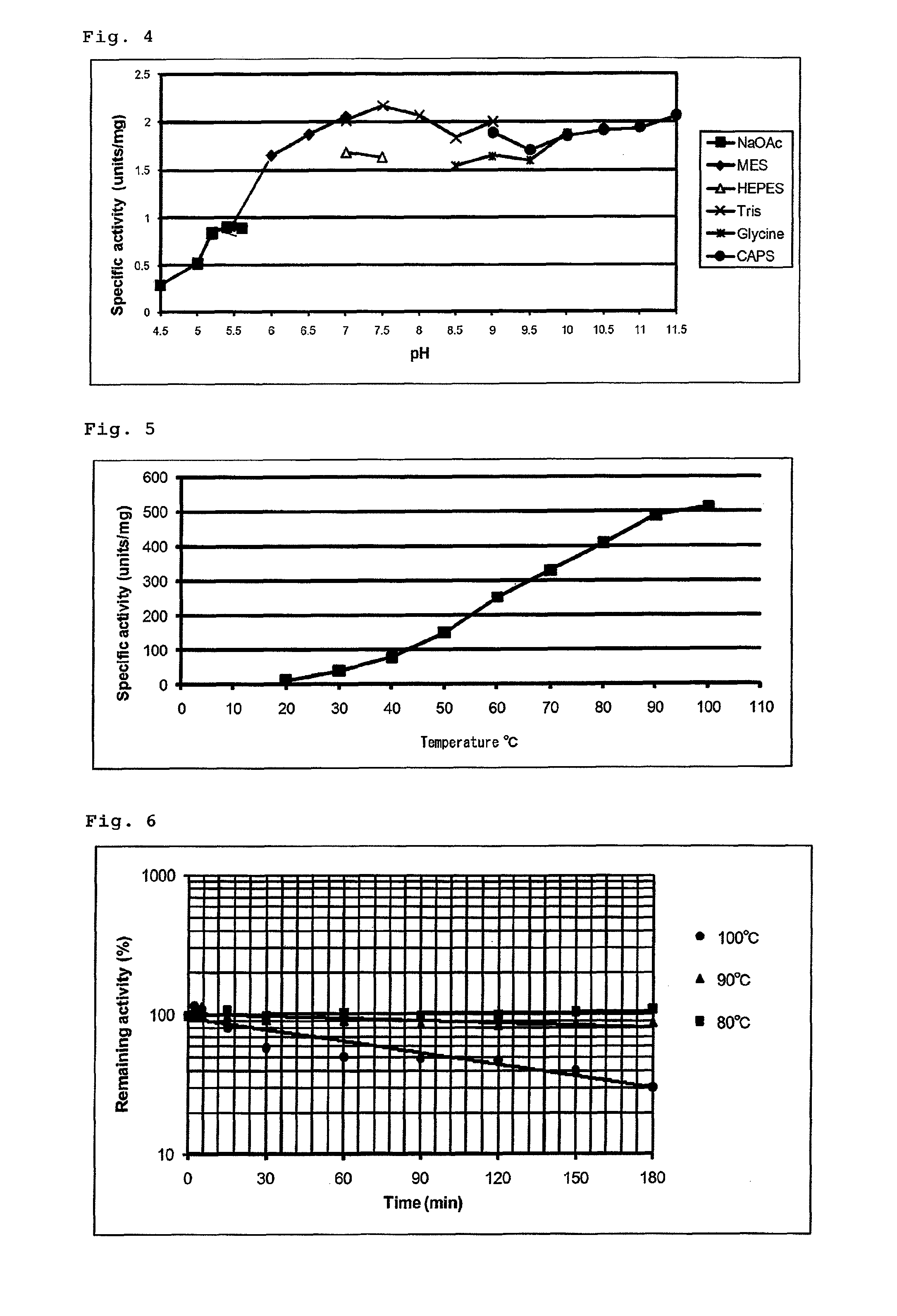Protease and use thereof
a protease and protease technology, applied in the field of protease, to achieve the effects of low substrate concentration, high activity, and high stability of protein denaturants and surfactants
- Summary
- Abstract
- Description
- Claims
- Application Information
AI Technical Summary
Benefits of technology
Problems solved by technology
Method used
Image
Examples
example 1
Preparation of Novel Protease (Tk-SP)
1-1. Expression and Purification of Pro-Form (proTk-SP)
[0110]Based on the genomic information on Thermococcus Kodakaraensis KOD1 (ACCESSION: AP006878), for expression of a pro-form which excludes the putative signal sequence (pre-sequence) from the deduced amino acid sequence (ACCESSION: BAD85878, SEQ ID NO: 7) of the base sequence predicted to encode a subtilisin-like serine protease precursor (ACCESSION: AP006878 REGION: 1484233 . . . 1486224, SEQ ID NO: 8), and contains the putative pro-sequence and mature sequence, a primer pair for amplification of a DNA fragment predicted to encode the pro-form was designed. The primer pair consists of a forward primer having an NdeI site (5′-GGCCTTTATCATATGGCCCCCCAGAAG-3′ (SEQ ID NO: 9)) and a reverse primer having a BamHI site (5′-GGCCTTGGATCCTCACCCGTAGTAAAC-3′ (SEQ ID NO: 10)). Using the primer pair and using the genomic DNA of KOD1 as a template, PCR was performed to amplify the DNA fragment. Digestion ...
example 2
pH Dependence and Buffer Dependence of Tk-SP
[0116]For examination of the pH dependence and the buffer dependence of the Tk-SP, enzyme reactions were performed using acetate buffers (pH 4.5, 5.0, 5.2, 5.4 and 5.6), MES buffers (pH 5.5, 6.0, 6.5 and 7.0), HEPES buffers (pH 7.0 and 7.5), Tris-HCl buffers (pH 7.0, 7.5, 8.0, 8.5 and 9.0), glycine-NaOH buffers (pH 8.5, 9.0, 9.5 and 10.0) and CAPS-NaOH buffers (pH 9.0, 9.5, 10.0, 10.5, 11.0 and 11.5) in the following procedure. 100 μl of a reaction mixture containing a 50 mM buffer and 2 mM Suc-AAPF-pNA (synthetic substrate) was incubated at 20° C. for 5 minutes. To this, 0.1 μg of the Tk-SP was added and the reaction mixture was further incubated at 20° C. for 10 minutes. The reaction was stopped by addition of 10 μl of acetic acid, and then the amount of p-nitroaniline produced from the synthetic substrate Suc-AAPF-pNA was determined by use of the absorption coefficient of 8900 M−1 cm−1 from the absorbance at 410 nm in an ultraviolet spe...
example 3
Temperature Dependence of Tk-SP
[0118]For examination of the temperature dependence of the Tk-SP, enzyme reactions were performed using azocasein as a substrate at various temperatures ranging from 20 to 100° C. in the following procedure. 270 μl each of a reaction mixture containing 50 mM Tris-HCl (pH 7.0) and 2% azocasein was incubated at a different temperature for 5 minutes. To each reaction mixture, 30 μl of a 3.3 μg / ml solution of the Tk-SP (about 0.1 μg) was added and the reaction mixture was further incubated for 20 minutes. The reaction was stopped by addition of 200 μl of 15% trichloroacetic acid (the final concentration of 6%). After centrifugation (15,000×g, 15 min), 160 μl of the resulting supernatant was mixed with 40 μl of 2 M NaOH and the absorbance at 440 nm (A440) was measured. The amount of the enzyme required to increase the A440 value of 300 μl of the reaction mixture by 1 per minute was defined as “one unit.”
[0119]The results are shown in FIG. 5. From the result...
PUM
| Property | Measurement | Unit |
|---|---|---|
| pH | aaaaa | aaaaa |
| temperature | aaaaa | aaaaa |
| pH | aaaaa | aaaaa |
Abstract
Description
Claims
Application Information
 Login to View More
Login to View More - R&D
- Intellectual Property
- Life Sciences
- Materials
- Tech Scout
- Unparalleled Data Quality
- Higher Quality Content
- 60% Fewer Hallucinations
Browse by: Latest US Patents, China's latest patents, Technical Efficacy Thesaurus, Application Domain, Technology Topic, Popular Technical Reports.
© 2025 PatSnap. All rights reserved.Legal|Privacy policy|Modern Slavery Act Transparency Statement|Sitemap|About US| Contact US: help@patsnap.com



